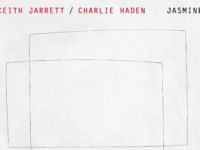Keith Jarrett and Charlie Haden hadn’t played together in over 30 years before getting together in Jarrett’s studio to work on these duets. The two men went their respective ways in the late 1970s. In the interim, there has been a lot of music-making. What’s particularly amazing about the just-released Jasmine is not that the players put their own essence on display (to great effect), but that it’s all so intimate, as if those decades had never passed.
There are many jazz duet records out there, though the ones that rise to the top have more going for them than proficiently-executed chord changes and in the pocket soloing. What makes the difference is often an intangible and subtle blending of experience, passion, and the ability to listen. Here I’m thinking of records like Bill Evans and Jim Hall – Undercurrent, Ron Carter and Jim Hall – Alone Together, and Chick Corea and Gary Burton’s Live in Zurich. The performances extend far beyond the musical material, floating the spirit of the song (and the song’s many pasts) in the air.
Charlie Haden sensed this during the recording process. His comment, “…and the music, it was like it was just being born,” provides a nearly perfect description. Nearly perfect, because the music and your own experience with it are what truly counts.
So how to describe the interplay of Jarrett and Haden? Though both men can take the music in an “out” direction, this was obviously not the time. Jarrett seems truly inspired by the roll that Haden takes on as bass player. Pat Metheny often describes Charlie as having “his own thing,” and he’s certainly right about that. Never one to be flashy, he is also prone to stepping away from being the timekeeper/watcher of the harmonic structure, venturing off into melodic flights that only imply the underlying structure. That’s what makes the interactions between Jarrett and Haden so delicious.
To use just one example (because seriously, there are hundreds on this album), Kern & Hammerstein’s “Don’t Ever Leave Me” ends with Jarrett surrounding Haden’s fragment of the theme with a series of full, gorgeous chords. To my ears, this was the pivotal point of the collection. It felt like it had more weight than all the others, Jarrett and Haden saying “Here, this is what we’re about.”
In the liner notes, Jarrett states that both art and listening are dying in our world, with intimacy being shattered by things that push us apart. I know where he’s coming from. It is my hope that pieces of art such as Jasmine can rise above mere nostalgia, to not just create a buffer against “progress” but to begin to heal the wounds opened by the unforeseen effects of the inevitable move forward.


